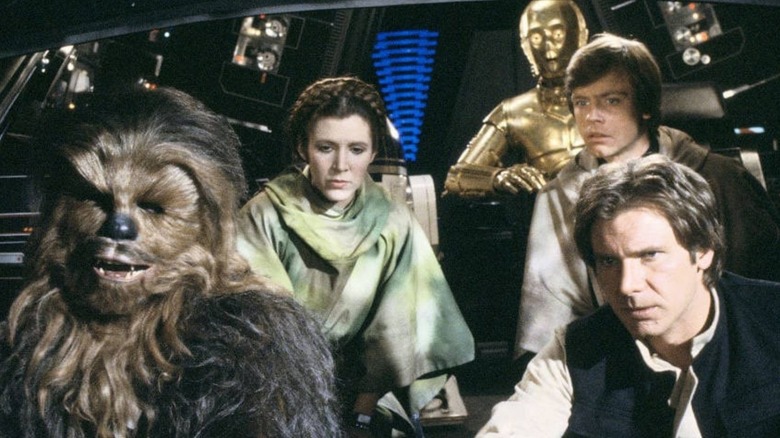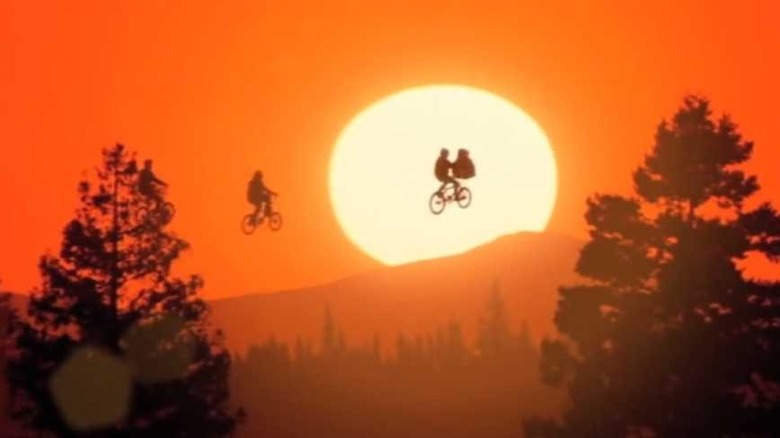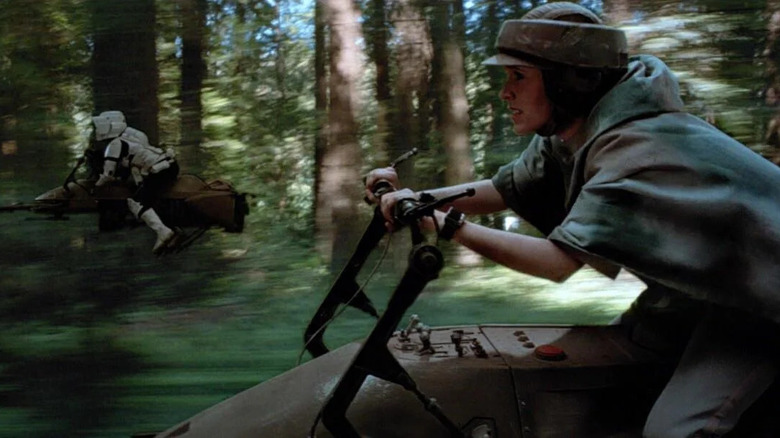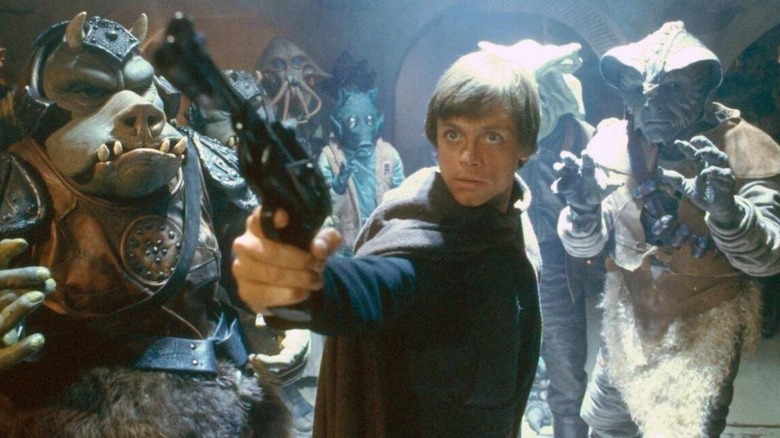Behind The Scenes Of Return Of The Jedi Was Less Stressful Than Empire And A New Hope
Changing the face of an entire artistic medium is no easy task. The special and visual effects pioneers who worked on the original 1977 "Star Wars: A New Hope" found that out the hard way when making the groundbreaking film, with director George Lucas pushing them to invent new methods of filmmaking in order to realize his vision.
Yet within the space of about six years, the moviemaking landscape had changed and developed to such a degree that by the time the third "Star Wars" film, titled "Return of the Jedi," was ready to be made, the challenge of putting massive space battles and giant sluglike creatures on screen was far less daunting.
Still, that doesn't mean making "Jedi" was a walk in the park (or forest moon, for that matter). People like visual effects artist Dennis Muren and others had to find ways of keeping the film's effects up to the high standards of the prior movies, and it's possible they wouldn't have been able to do it without their experiences on "A New Hope" and "The Empire Strikes Back."
ILM had to juggle Jedi with a busy slate of effects-heavy films
After "Jaws" kick-started the blockbuster movie boom and "Star Wars" created an appetite within audiences for dazzling feats of visual effects, the Hollywood production slate was brimming with films whose box office expectations and effects requirements were exponentially increasing. While the effects house Industrial Light & Magic had been formed initially to work solely on "Star Wars," by 1982 the company was deluged with projects.
As Dennis Muren recalled in 2013 interview with StarWars.com, he was approaching working on "Jedi" while still feeling "exhausted from barely finishing 'E.T.," which was made for a relatively small budget when it came to the effects work. Steven Spielberg's heartfelt alien-on-Earth adventure was far from the only movie ILM had been hired to help make at the time; in between the release of "Empire" in 1980 and "Jedi" in 1983, ILM and Muren were involved with a number of effects-heavy features. "I was working on 'Dragonslayer' and 'E.T.,'" Muren recalled. "'Star Trek' [II: The Wrath of Khan] was in there, 'Raiders [of the Lost Ark]' was in there, 'Poltergeist' was in there."
Of course, all the experience ended up helping make "Jedi" a smoother experience behind the scenes. Muren observed:
"It was not nearly as difficult as 'Empire' or 'Star Wars,' because we had done it before ... by the time we got to 'Jedi,' we had done a lot of work, and we had a lot of equipment. We were really set up and we knew how to do it, and then it was a matter of doing it."
Jedi had its challenges despite ILM's experience
Just because the effects artists at ILM were old pros by the time "Jedi" was being made doesn't mean things went smoothly behind the scenes. Some sequences, such as the Rancor attack beneath Jabba the Hutt's palace, took several attempts to find the right technique to use.
While effects-heavy scenes like the spaceship attack on the second Death Star and the climactic lightsaber duel between Luke Skywalker and Darth Vader were returning to tried-and-true techniques used in the first two "Star Wars" films, the speeder bike chase in "Jedi" provided ILM with a whole new challenge. Dennis Muren knew the portions of the sequence featuring the actors would be done with blue screen, but he had to figure out a way to convey the intense sense of speed with which the bikes traveled through the forests of Endor.
The breakthrough came when Muren had the idea to shoot background plates with a Steadicam, a piece of equipment that was still new to the film industry at the time and allowed a camera operator to offset the weight of a camera while having an autonomy of movement. Muren recalled to StarWars.com how he "called Garrett Brown up, who invented it, and he flew out from back east and we did a test out in Samuel Taylor Park out here, with him just walking along with the camera, shooting one frame a second. And the thing worked."
Jedi and the Star Wars films made visual effects history by taking risks
Along with the prior "Star Wars" films, "Return of the Jedi" pioneered not just the way visual effects were accomplished, but also the way they were handled. The normal procedure for visual effects in Hollywood these days is for a production to divide up the work for the entire film and assign it to different vendors, something Dennis Muren found ILM doing by necessity on "Jedi." He went on to explain:
"There was so much work from an effects standpoint, we split it into three sections ... it just made sense that you could focus more on each shot and make it better if you weren't dealing with too many shots."
The approach helped "Jedi" make it to movie screens in time for its May 25, 1983 opening, and its financial success proved once again how the risks taken by Lucas and ILM could pay off in a big way. As Muren observed:
"Every one of these ['Star Wars' films] could have been a disaster if one of them didn't work, because George [Lucas] put his own money into it. Nobody wants to see anyone go through something like that. To take a risk like that is pretty brave, and he set up a great place for us to work and gave us a lot of freedom in order to be creative."
While the making of "Jedi" was no picnic, it proved that visual effects movies on that level of scale and quality could become more commonplace, and it is thanks in large part to the original "Star Wars" trilogy that the visual spectacles audiences have enjoyed for the last 40 years have been able to continue and grow.



